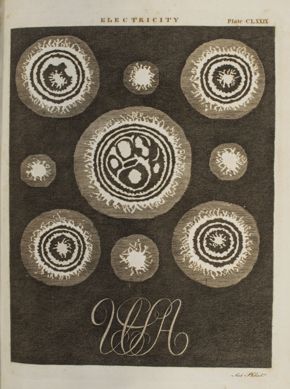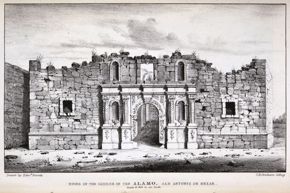Acquisition Highlights
A few special additions to the Powell Library’s collection of over 11,000 volumes are highlighted below. To consult the books in person, visit the Kitty King Powell Library and Study Center or call the library at 713.353.1542.
The First American Encyclopedia

“Electricity,” Plate 174 in Encyclopaedia, or, a Dictionary of Arts, Sciences, and Miscellaneous Literature, Philadelphia: Thomas Dobson, 1789-1804, the Museum of Fine Arts, Houston, Powell Library, gift of William J. Hill.
“Electricity,” Plate 173 in Encyclopaedia, or, a Dictionary of Arts, Sciences, and Miscellaneous Literature, Philadelphia: Thomas Dobson, 1789-1804, the Museum of Fine Arts, Houston, Powell Library, gift of William J. Hill.
“Drawing,” Plate 172 in Encyclopaedia, or, a Dictionary of Arts, Sciences, and Miscellaneous Literature, Philadelphia: Thomas Dobson, 1789-1804, the Museum of Fine Arts, Houston, Powell Library, gift of William J. Hill.
“Felis,” Plate 191 in Encyclopaedia, or, a Dictionary of Arts, Sciences, and Miscellaneous Literature, Philadelphia: Thomas Dobson, 1789-1804, the Museum of Fine Arts, Houston, Powell Library, gift of William J. Hill.
“Crystals of Salts,” Plate 152 in Encyclopaedia, or, a Dictionary of Arts, Sciences, and Miscellaneous Literature, Philadelphia: Thomas Dobson, 1789-1804, the Museum of Fine Arts, Houston, Powell Library, gift of William J. Hill.
“Flags,” Plate 194 in Encyclopaedia, or, a Dictionary of Arts, Sciences, and Miscellaneous Literature, Philadelphia: Thomas Dobson, 1789-1804, the Museum of Fine Arts, Houston, Powell Library, gift of William J. Hill.
Encyclopaedia, or, a Dictionary of Arts, Sciences, and Miscellaneous Literature, 1789–1804
A copy of the first encyclopedia published in the United States recently entered the Powell Library’s collection, thanks to generous funding from William J. Hill. The 23 leather-bound volumes of Encyclopaedia, or, a Dictionary of Arts, Sciences, and Miscellaneous Literature were printed in Philadelphia between 1789 and 1803 and broke new ground for American publishing. Although based on the third edition of the Encyclopaedia Britannica, these volumes were printed on American-made paper, with American-made type, and illustrated with 595 plates engraved by American artists after the British originals. In addition the publisher made changes and additions to the British text and illustrations for the American audience.
Philadelphia publisher, printer, and author Thomas Dobson first announced his plans not long before George Washington’s inauguration as the first president in Philadelphia on April 30, 1789. The nation’s founding fathers, including Washington, Jefferson, and Hamilton supported the project by subscribing. When the set was completed in 1798, Dobson embarked upon a three-volume supplement that included more new articles about America.
More than 500 engraved plates visually document 18th-century knowledge in areas including natural history, geography, science, and engineering. At least 18 American artists produced them, with Robert Scot and his apprentices responsible for the majority. The Powell Library’s copy of this major work enables researchers and visitors to view these original engravings and the 16,650 pages of text that Dobson successfully published at this formative period in American history.
Early Images of San Antonio

“Ruins of the Church of the Alamo,” Memoir Descriptive of the March of a Division in the United States Army, United States 31st Congress, 1st session (1849–50), Senate Ex. Doc. No. 32, the Museum of Fine Arts, Houston, Powell Library, gift of William J. Hill.
“Interior View of the Church of the Alamo,” Memoir Descriptive of the March of a Division in the United States Army, United States 31st Congress, 1st session (1849–50), Senate Ex. Doc. No. 32, the Museum of Fine Arts, Houston, Powell Library, gift of William J. Hill.
“Mission Concepcion,” Memoir Descriptive of the March of a Division in the United States Army, United States 31st Congress, 1st session (1849–50), Senate Ex. Doc. No. 32, the Museum of Fine Arts, Houston, Powell Library, gift of William J. Hill.
“Mission of San Jose,” Memoir Descriptive of the March of a Division in the United States Army, United States 31st Congress, 1st session (1849–50), Senate Ex. Doc. No. 32, the Museum of Fine Arts, Houston, Powell Library, gift of William J. Hill.
“San Antonio de Bexar,” Memoir Descriptive of the March of a Division in the United States Army, United States 31st Congress, 1st session (1849–50), Senate Ex. Doc. No. 32, the Museum of Fine Arts, Houston, Powell Library, gift of William J. Hill.
Memoir Descriptive of the March of a Division of the United States Army, Under the Command of Brigadier General John E. Wool, from San Antonio de Bexar, in Texas, to Saltillo, in Mexico, 1849–50
Surprising works of art can be discovered in routine publications of the United States government, and a small U. S. Senate report in the Powell Library provides an outstanding example. Donated by William J. Hill, this report from the Mexican War includes one of the first published lithographs of the Alamo to have been made from an eye-witness drawing. In addition to that depiction of the pre-restoration, crumbling ruin, the book also contains lithographs of the Alamo’s interior, the façade of the Mission of San Jose, and a view of Mission Concepcion.
Curtis Burr Graham made the lithographic plates from drawings and watercolors by London-born Edward Everett in 1846. Everett worked as a machinist and engineer in Illinois before joining the U. S. Army in 1843. Sent to Texas in 1846 for service in the Mexican War and assigned to collect information on the history and customs of the San Antonio area, he began sketching and drawing the Alamo and other missions. He also helped remodel part of the Alamo for military offices and storage. When Major George W. Hughes, chief topographical engineer for General Wool prepared a report of Wool’s march to Mexico, he commissioned Curtis Graham to make four lithographs from Everett’s San Antonio drawings for the publication.
These visual documents of early Texas finally reached the public in 1850 through a slim government publication with a very long title!
